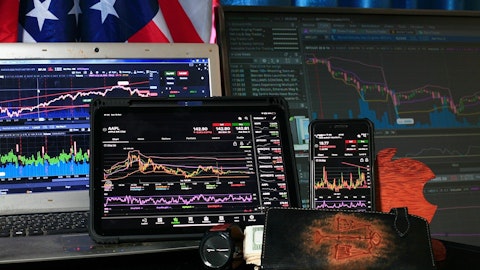Operator: And we will take our next question from Trevor Cranston with JMP Securities.
Trevor Cranston: Hey. Thanks. You guys mentioned this sort of near-term outlook for spreads, you expect them to be kind of range bound and to remain correlated with other risk assets? Can you maybe talk a little bit about your outlook for interest rates this year, including kind of how you guys are thinking about volatility trending over the course of the year? Thanks.
Smriti Popenoe: Wow, Trevor, you asked me if I have a crystal ball. It is, I would say like, I have been in these markets for a long time. And I think the environment that we are in is, it is among the most difficult environments that I have sat in, in the last 30 years to be able to look forward and say, with any degree of confidence, that x, y or z is going to happen with respect to interest rates, okay. We do have a name for it here. We are calling this flat distribution with fat tail for a reason, which is that it is really, really hard to come to a conclusion about inflation, the level of inflation, the level of growth, the exogenous events that could happen. It’s really difficult to say things are going to go in one direction or another.
So, we have actually got a very neutral predisposition to interest rates. You can see that in our risk position, up or down, curve shocks were pretty flat, because this is in an environment where you can €“ we think you can actually put your shareholders’ capital at risk for those types of moves, because you are not as certain about that. So, that we €“ leads us to that kind of a risk position. So, we are in that €“ our view on interest rates right now is, you cannot predict, you cannot predict. I would say the other thing that that informs us and I mentioned this in my comment is, the last 15 years we have had a massive distortion from quantitative easing, whether people necessarily recognize it or not, it’s been a massive factor in the price of risk.
And you are now entering an environment where that is actually being taken away globally by all central banks. And so the price of risk has to change. It’s going to happen slowly over time, potentially, shocks like September or October, those are going to be more normal as the liquidity gets taken out of the system. So, you don’t want to lean too far in one direction or another in terms of interest rates. And so all of these things lead us to say, better have a more neutral kind of position with respect to that. Now, the markets have done an incredible thing here by being very confident that interest rates are going to come down. And we will see what the Fed has to say about it later this week. But we are not ready to go in that same €“ in the same direction per se.
Trevor Cranston: Thanks Smriti. Just can you talk about how wrong the market has been? That’s an important point that is overlook and most people don’t see the forward curve and see where the market was predicting rates just a year ago, 1.5 years, the market has been wrong throughout time, it had been extremely wrong recently. Can you just discuss that a little bit?
Smriti Popenoe: Yes, sure. I mean like the €“ if you look at the forwards on December, in December of 2021, I mean the market would have told you that interest rates will be up at like 50 basis points or 75 basis points at the most, right. So and look, even the Fed didn’t really believe that inflation was something, really they had, if you guys remember they had FAIT, remember that thing, flexible average inflation targeting. That was basically saying we are going to average inflation out over time and so we can stay more dovish. All of that has gotten thrown out the door. So, the ability to predict here is very, very hard. And look, in general, predictions are hard. We try not to predict here much. And so that’s kind of what informs our opinion.
Byron Boston: Yes, but . And throughout time, there are better probability distributions than we have today for investing money. This is and it’s very important, we will stand firm on this at Dynex Capital. This is an evolving environment. And you have one of your best ways to understand and look back at the forward curve, and look at how wrong the market has been this decade. And then consider the surprises that have happened. We came into this decade, we believe surprises were highly probable. Not only have we had surprises, but almost all have come from overseas. You have first, you had the pandemic, then we had the government response to the pandemic, then you had inflation, we had another government response, and we had a war and then we had the craziness that came out of Britain in September.
So, when you start to talk about a prediction, and anyone wants to forecast, any economists, I want to ask you what precedence you are going to do, what is Russia going to do. And then that can go down a huge list of other questions for you that will challenge your forecast. And then finally, one of the best statements that Jay Powell made this year is when he said you can’t trust any forecast today. That’s our opinion at Dynex.
Trevor Cranston: Okay.
Byron Boston: Some of you €“ some people would believe us, and some will disagree.
Trevor Cranston: Okay. I appreciate that. That’s a good perspective. Thank you.
Smriti Popenoe: Thanks Trevor.
Operator: We will take our next question from Bose George with KBW.
Bose George: Yes. Good morning. Actually wanted to ask just about this current levered ROE, I mean you guys noted this is above the dividend, but just any more color on kind of a range of where current ROEs are would be great?
Smriti Popenoe: Right. Yes, I think the €“ what I would say, so I quoted just 7x leverage, because that’s the leverage to common that we have on right now. I would say that €“ so we are assuming the spreads of about 125 to 130, 135, there about. Those are in the 13 to 15 ROE, depending on the coupon that you pick out. And this is for like 4.5 to 5. That would be where they are at the moment.
Bose George: Okay. Great. Thanks. And then actually, you have noted that you didn’t sell assets during the quarter or nothing meaningful in terms of recovering book value. But just on the TBAs side, with the TBA positions that were closed, I mean were there sort of losses there to think about?
Smriti Popenoe: I mean, yes, you get one thing we did disclose right at the end of last €“ I mean during our conference call in our earnings presentation for the third quarter was a change in our risk position. So, if you go back to the third quarter earnings deck, we provided information, not only in terms of our interest rate risk, but also our spread risk exposure, which declined during the early weeks of October. So, that was in our numbers for the full quarter.
Bose George: Okay. Thank you. And just from a P&L standpoint, is that €“ are those changes, is that floating through that derivatives line, along with the TBA drop income?
Smriti Popenoe: It should be in there, yes.
Bose George: Okay. Great. Thanks very much.
Smriti Popenoe: Thanks Bose.
Operator: Our next question comes from Christopher Nolan with Ladenburg Thalmann.
Christopher Nolan: Hey, guys, quick question. Follow-up on Bose’s question on leverage, does that 7x include TBA or was that simply just that?
Smriti Popenoe: Yes. It includes TBAs, Chris.





